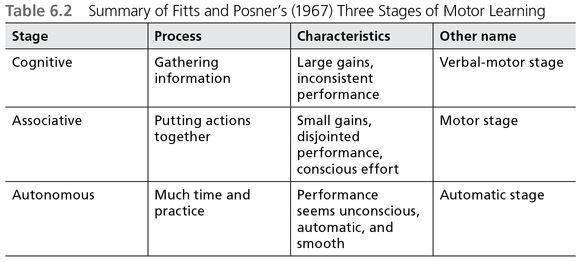In our CrossFit classes, we’ve been working on our Olympic lifts by performing barbell complexes – a sequence of movements strung together in order. A single rep is fairly challenging and doing a few in a row can be exhausting (I don’t think I’ve ever heard as many complaints about anything as when we performed 3 sets of 3 reps of the snatch complex). You might wonder why we perform them, and with good reason. No, the goal is not to simply crush you and make you tired. To understand the purpose, we must first understand the motor learning process – how we learn new movements.
There are three stages in motor learning: cognitive, associative, and autonomous. Rather than delve into textbook definitions, I’ll just give a brief overview of each.

Cognitive – during this phase, and athlete begins to understand WHAT to do. If someone described a clean to you, it would be very difficult to visualize without watching a demonstration. So, coaches provide demonstrations, and explain what to do. Athletes in turn play around with the movement. We expect to see large performance gains as athletes begin to understand what they’re doing, but there will be inconsistent performance. Think back to the first few times you tried snatching, or kipping, and how you could get an occasional good rep, but still had many that weren’t quite right. That’s the cognitive stage.
Associative – During this stage, the athlete understands what to do, and works on making small adjustments based on feedback from coaches. We expect small gains in performance as technique improves.
Autonomous – In this final stage, movement is automatic. The athlete doesn’t need to focus on the movement itself and can instead focus on the bigger picture. A good example would be a high level basketball player who doesn’t need to focus on dribbling and can instead pay attention to where his teammates and defenders are on the court. In the sport of CrossFit, it would mean focusing on pacing and breathing rather than each individual rep.
It takes YEARS of dedicated practice to reach the autonomous stage for any movement. Most of us live in the associative phase – there is always something to improve upon. And, with movements as complex as the Olympic lifts, it’s not uncommon to develop bad habits, or less than ideal movement patterns due to muscle imbalances. As we grow stronger and correct those imbalances, we can hold ourselves in better positions. BUT, to break a bad habit, we go back to the cognitive stage, and grow to the associative stage once again from there. The process can be cyclical, not just linear.
To learn an advanced gymnastics skill like a muscle-up, or a complicated lift like the snatch, we break the movements down into pieces, and then put them back together. Each piece is designed to focus on a fundamental part or aspect of the movement. In the case of the Olympic lifts, many of these drills emphasize and exaggerate a part of the movement. Take the tall snatch and tall clean. These movements are challenging, because we remove the leg and hip drive. In other words, your primary power generators are taken away. As a result, you’re forced to pull yourself under the bar as fast as humanly possible. In the full lifts, we want speed under the bar, but assuming the other pieces of the lift are done correctly, it won’t be necessary to the same extent.
Lifting complexes are effective ways to train the constituent pieces of a lift, and then put them back together. They are designed to make you BETTER. And they’re exhausting for a couple reasons. First, it’s a lot of time under tension. I’ve talked about higher rep lifting and how it doesn’t equate to cardio previously. As a very quick recap, time under tension spikes your heart rate, because the weight compresses your blood vessels. Your heart pumps harder and faster to re-expand them. Breathing and heart rate follow one another, so with the elevated heart rate comes heavier breathing.
Second, it’s neurologically draining. Neurons are the cells that transmit signals from your brain to your muscles. In order to do this they use energy from carbohydrates. The more muscular work that you do, the more energy is needed by your nervous system. Performing multiple reps in a complex, especially when involving every muscle in the body in coordinated movement, requires A LOT of energy. It is literally exhausting. We call these types of movements “global movements.” CrossFit is filled with them, which is how it earned it’s reputation as being super intense.
At the end of the day, yes, complexes are tough. They’re supposed to be. Learning movements can be difficult, and more so if you have bad habits to break. It’s part of the process, and it will get better. Just know that there is a reason behind it, and we’re here to make you better, not just beat the crap out of you. Thanks for reading, and see you in the gym.
